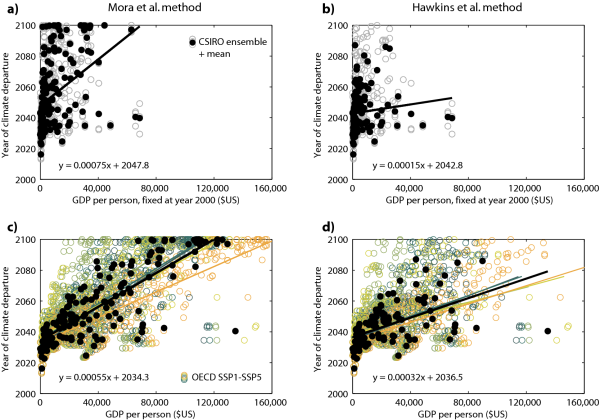A previous post discussed the recent Comment on Mora et al., which considered mainly methodological & statistical errors. However, the erroneous assumptions regarding uncertainty in the Mora et al. study have further implications for their results on population and income.
Guest post from Flavio Lehner (Uni. Bern)
Mora et al.‘s remark that “[…] the earliest climate departures occur in low‐income countries further highlights an obvious disparity between those who benefit economically from the processes leading to climate change and those who will have to pay for most of the environmental and social costs” depends on a country‐based comparison of the year of climate departure and the current Gross Domestic Product per person (GDPP).
Indeed, tropical countries tend to have an early climate departure and low present‐day GDPP. However, the robustness of the Mora et al. statement is also dependent on three factors not accounted for by the authors:
1) Year of climate departure: As shown by the Hawkins et al. Comment, the more conservative and correct method to estimate the year of climate departure yields significantly fewer regions with climate departures before 2100. Applying this to the GDPP data reduces the slope of the relation between year of climate departure and income by a factor of five (compare Figure 1a to 1b). It becomes obvious that a number of lower‐income countries (GDPP<20,000 $US) in fact do not experience a climate departure.
2) Economic and societal scenarios: By keeping the GDPP fixed at year 2000 levels, Mora et al. neglect the possibility that the GDPP of a country can change in the future and might be different by the time of climate departure. This uncertainty can be addressed by taking into account different scenarios of future GDPP development, all compatible with the emission path of the RCP8.5 scenario. We find the relation between income and year of climate departure to depend significantly on such considerations (compare Figure 1c and 1d to 1a and 1b).
3) Vulnerability and adaptability: Finally, it is questionable to what extent the year of climate departure based on annual or monthly temperature together with GDPP is a good metric for vulnerability and adaptability of ecosystems and societies. There is a range of more subtle metrics that, when applied to climate models, would lend such a policy‐relevant study much more credibility (Sillmann et al., 2013, Fischer et al., 2014)

[Note from Editor: Have any other possible issues been identified with Mora et al.? Will consider further guest posts on the topic.]
2 thoughts on “More Mora emergence issues”